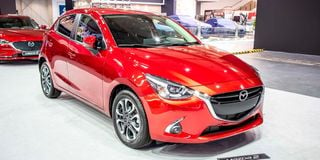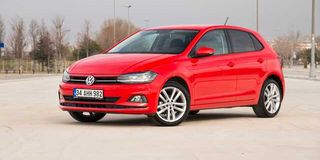Premium
The Demio is now an established model here, getting spare parts for it shouldn’t be difficult…

Mazdas are regaining popularity in Kenya after some years in the doldrums, and the number of sales and service and parts outlets are expanding to match.
My car is a Mazda Demio, and it has proved quite difficult to get spare parts for it.
Could you assist me by connecting me to where I can get a ‘link assembly front stabiliser? I have been in contact with car dealers, including Toyota (K), but it has proved difficult to get spare parts for Demios. Lucy M.
Mazdas are regaining popularity in Kenya after some years in the doldrums, and the number of sales and service and parts outlets are expanding to match.
The brand has main agents, branches, approved dealers and independent specialists. I understand there is even an owners’ club called Team Mazda Kenya. A quick visit to the internet will give you lots of connections. The Demio is now an established model here, and stabiliser links are not an obscure component.
After 30 years of the mitumba avalanche, Kenya is now one of the best places in the world for quickly sourcing hard-to-find components for almost any make. The market has spawned an army of brokers doing exactly that – full-time.
Workshops, large and small, in main centres or in small and remote towns, have systems for getting almost any part, almost instantly, delivered almost anywhere (often in a matter of hours).
All they need is a picture of the part on WhatsApp to trigger a nationwide network search, find the bit, pay for it with M-Pesa, and get it to where it needs to be, using matatus and boda bodas with ingenuity, speed and economy that would astonish the most efficient delivery systems in the Western World.
For example, I was completely stranded when the fanbelt tensioner bearing on my 2004 Mahindra Scorpio seized when I was in a distant corner of Meru National Park, 100 km of dust and rocks from anywhere. I WhatsApp’d a picture of the part to my regular garage in Naivasha.
A new part was sourced within an hour in Nairobi and dispatched to a garage in Nanyuki, where a newer Scorpio was being serviced. Meanwhile, the used tensioner bearing on that Scorpio was cannibalised and sent by matatu to Maua, where it was collected by a mechanic who brought it to the Meru Park gate by boda boda, and arrived at my location with Rangers on a Park water bowser just before midnight.
My car was restored to full function, and the next day in Nanyuki, the brand new part was fitted to the cannibalised vehicle. In this respect, Kenya is in a class of its own!
The oil brand is just a promotional business deal between the car company and oil company

The Castrol recommendation is a promotional business deal between a car company and an oil company. It is not a technical essential. Good quality multiweight oil from any of the major international brands will be equally safe and effective.
Hi Gavin,
I’m a fan of your motoring column. Well done! I own a 2015 VW Golf 1200cc TSI. What is the most suitable engine oil for it, 5w-40 or 5w-30, mineral or synthetic? Also, the manufacturer recommends Castrol on the engine cap. Any issue with using other brands? Finally, it’s now at 158,000 km mileage. At what point will I switch to high-mileage engine oils?
Fundi K
The Castrol recommendation is a promotional business deal between a car company and an oil company. It is not a technical essential. Good quality multiweight oil from any of the major international brands will be equally safe and effective. Either of the oil weights you suggest will give adequate protection to your engine.
You can use mineral or semi-synthetic or fully synthetic oil. The nearest you can afford to the SN grade will give you the best results.
I am aware of oils designated “high mileage” and their claims that they can reduce “leakage” and “blow-by” on well-worn engines.
I’m sceptical because if your exhaust is not blowing blue smoke, a special “sealing” oil is not necessary. If the exhaust is already blowing blue smoke, it is already too late for a “sealing” oil to be helpful. If your engine is burning a lot of oil, the remedy is to replace the piston rings, and if necessary, the cylinder sleeves. You can check the degree of wear with a simple, quick and inexpensive compression test.
New or Used: the choice boils down to budget
Hi,
Is it better, or wiser, to buy a brand new VW Polo from DT. Dobie for about Sh1.6m rather than import a seven-year-old compact Japanese vehicle for about Sh400,000 less than that? Kinyanjui K

A new car will be more expensive to buy and more expensive to fully insure, but it will probably be cheaper to run (better fuel economy, fewer replacement parts), it will have a solid warranty, it should be more reliable, and several years down the road it will have a higher resale value.
Whenever there is a question with the phrase “which is better” in it, the answer is almost never that one is right and the other is wrong. It is simply a choice. In my view, a new car will be more expensive to buy and more expensive to fully insure, but it will probably be cheaper to run (better fuel economy, fewer replacement parts), it will have a solid warranty, it should be more reliable, and several years down the road it will have a higher resale value.
The decision is more complex if you are comparing a new vehicle of one make and model with a used vehicle of a different type or class. Then it is not just a question of economics over time (whether the big cost is now, ongoing or at the end), but also a matter of personal preference and optimal utility for your motoring needs. The choice boils down to your budget for the class of car your motoring patterns require. The depreciation rates of both options you are looking at are also worth checking. Also, how “old” are seven years? For low-cost little cars, seven are usually middle-aged. For top quality bigger cars, it is still quite young.
Trying to silence cars that ‘talk’ too much
Hi Gavin,
My ex-Japan X-trail (2014 model) has a noisy pre-recorded Japanese language voice that squawks at start-up start and even during driving. Since I don’t understand the language, it only distracts me. How do I get rid of it, please?
Anthony

And so say almost all of us, even if the warning system uses a more multilingual system of ding-dong bleeps and chimes and tinkles and jingle-jangles. Aaargh! The technology started as a good idea but has been taken to an over-the-top extreme.
And so say almost all of us, even if the warning system uses a more multilingual system of ding-dong bleeps and chimes and tinkles and jingle-jangles. Aaargh! The technology started as a good idea but has been taken to an over-the-top extreme.
All of these messages are triggered by switches linked to microprocessors, ultimately plugged into a loudspeaker. Some are important warning signals, and others are just helpful reminders. By law (in some markets) or some best-practice notion, they are specifically designed to be difficult to disconnect.
Difficult, but not impossible. One by one, you need to find their trigger (e.g in a seatbelt socket) and disconnect the wire leading from it. Hopefully, in time manufacturers will try to be helpful in a less intrusive way, and/or give their customers a selective switch that allows the non-essential messages to be simply turned off.
Licensed to Kill: Just how competent are Kenya’s driving schools?
Hi Mr Bennett,
Thanks a lot for all the precious gems that you have shared over the years. With your vast experience, do you have the driving manual of the 60s (red hardcover)? It was a very clear and well-illustrated guide. I don’t recall the title. Also, what is your opinion of the general standard of teaching at driving schools, and is the AA’s Premier Driving package worth three times the price of regular lessons? I believe the red handbook and regular-cost lessons would be okay.
Keith.

Because Kenya’s motoring is based on British origins, the handbook I would recommend is the successor to the original ‘red book’. It is produced by the UK’s Driving Standards Agency and is called ‘Driving – the essential skills’.
I have not done a detailed survey of driving schools or the driving test for many years, so anything I know about their current status is based on hearsay. I did thorough “investigative journalism” on the subject about 40 years ago, by first personally passing the most advanced international tests I could find (including the Institute of Advanced Motorists examiner-of-instructors course) and then – posing as a beginner - taking local lessons at three different driving schools and then taking the local driving test.
The editors who published my findings on aspects like tuition standards and corruption entitled the resultant centerspread article “Licensed to Kill”. I have not heard or seen anything since which suggests those standard shortfalls have been effectively addressed, nor have I come across a new ‘Kenya Highway Code’ that is clear, comprehensive, accurate, illustrated and indexed, either in print or on “open access” internet. Dare we count the number of road deaths and serious injuries in the intervening years?
There is, of course, a huge capacity for motorists to self-teach, and there are handbooks available for that. Although much of our motoring – from policy to driving to road management – remains !!xpj*fk*n!! (sic), observation suggests an increasing number of drivers are considerably improving their skills and conduct by some such means and the all-important principle of “common sense and courtesy”.
Because Kenya’s motoring is based on British origins, the handbook I would recommend is the successor to the original ‘red book’. It is produced by the UK’s Driving Standards Agency and is called ‘Driving – the essential skills’. As a perspective on what driving lessons “should” be taught, the dusty version on my bookshelf is 340 pages long and weighs nearly a kilo.
The DSA’s sister manual of similar vintage on the “theory test” for drivers and motorcyclists, which lists every question and answer any licenced driver “should” know, is even bigger at 420 pages – about 10 times more material than the East African Road Safety Training Centre’s “Driving Test Guide for Kenya”, and 20 times the content of EARSTC’s Highway Code Guide for Drivers and Riders.
Serious driver competence is not a small undertaking.
***
Do you have a motoring question? Email [email protected]





